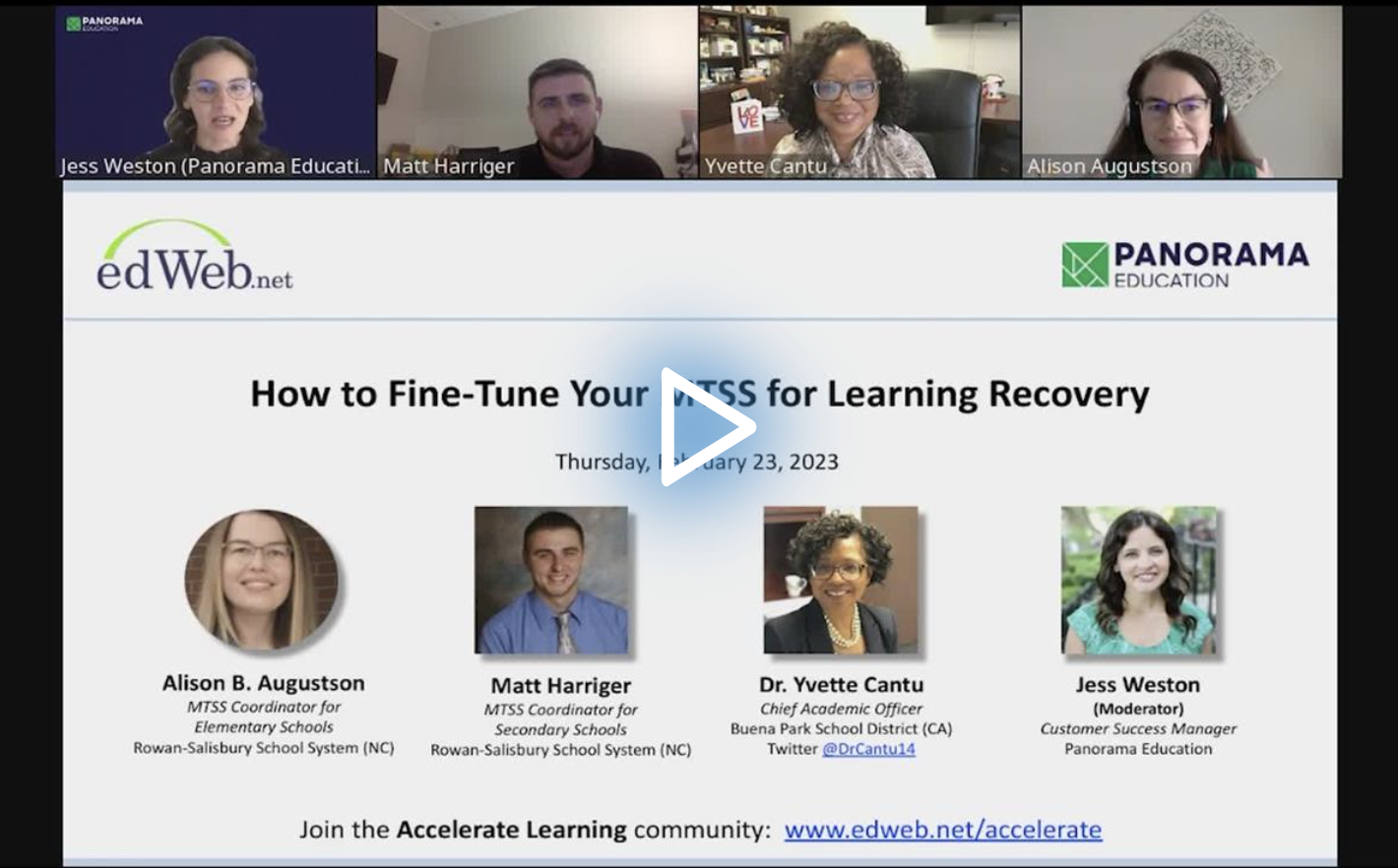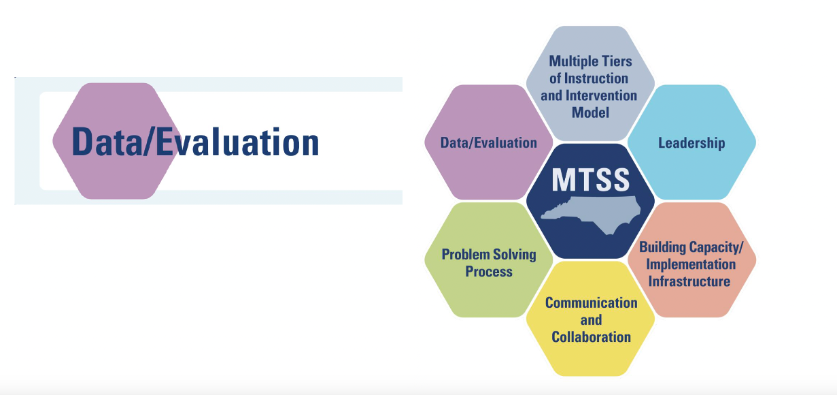Strategies to Fine-Tune Your MTSS for Learning Recovery
Watch the Recording Listen to the Podcast
When the Nation’s Report Card for 2022 was released by the National Assessment of Educational Progress (NAEP), the declines in student reading and math scores were alarming, but for many, the data was not surprising.
With many students spending almost two years learning from home, educators instinctively knew learning loss would occur. With the NAEP data confirming what they suspected, educators are now working to create strategies for systemic interventions that include tools to monitor student progress across a range of activities to ensure that students have the support they need to be classroom ready.
Understanding how to create Multi-Tiered Systems of Support (MTSS) by collecting and analyzing the right data was the focus of the edLeader Panel, “How to Fine-Tune Your MTSS for Learning Recovery,” featuring school leaders and moderated by Jess Weston, Customer Success Manager for Panorama Education.
Collecting the Right Data
Dr. Yvette Cantu, Chief Academic Officer for Buena Park School District (CA), along with Alison Augustson, MTSS Coordinator for Elementary Schools, and Matt Harriger, MTSS Coordinator for Secondary Schools, both from Rowan-Salisbury School System (NC), shared the processes they have used to collect and analyze data to create the systemic reforms needed to address both academic learning loss and social-emotional supports to ensure students are classroom ready.
In Buena Park School District, they use a student survey that captures data around wellness and academics. Panorama Education’s Panoramic dashboard not only collects the data but also synthesizes the data to provide a view of the whole student.
The data points include academic, social-emotional mental health, self-perceptions, perceptions about adults at school and their ability to cope with day-to-day activities. They are not only using the data to understand the needs of individual students but also the collective needs of the school and as such are able to create MTSS plans with a yearlong focus.
Dr. Cantu said the data has led Buena Park to prioritize three main areas:
- Adult-to-student connectivity: Building a culture that ensures there is a caring, supportive adult for every student in every school.
- Segmenting instruction with intentionality and rigor: Tier 1 is the best instruction for everyone; Tier 2 is identifying those students who need a second dose of Tier 1 instruction through small groups or even individual instruction; and Tier 3 is identifying those students who need intensive support.
- Equity in instruction: Using data to identify students who do not have the skills to access instruction and who may feel no one is there to support them.
Collecting the right data allows Buena Park to focus on these pillars to support the whole learning community—students, teachers, parents, and guardians.
Constant Progress Monitoring
To ensure that students do not slip through the cracks, Dr. Cantu shared that Buena Park uses their data to constantly monitor student progress. She says they use a 3-6-9 program where, every three weeks, they look at data as individual teachers and department leads. Then, every six weeks, they look at data more collectively at whole-grade levels as well as departments. Finally, every nine weeks, they look at data across a whole school and the whole district.
She says this allows them to “capture not just our student voice but our teacher voices as well as our parent voices” to better understand the needs of each group so they know how best to support them.
Taking time in the 3-6-9 approach to pause and look at the Panoramic dashboard helps the school or district plan for community-wide events or special events within the school building to make students and parents feel welcomed and heard. Even small things like placing a welcoming team outside the school in the mornings or having teachers inside the school giving high-fives as the kids come into class. The data provides insights into when these activities are needed and why.
MTSS Involves Everyone
Both Buena Park and Rowan-Salisbury school districts are very intentional about providing opportunities for professional learning communities (PLCs) to come together to review student data, analyze it as a group, and discuss how to work together to create a comprehensive response that includes supporting the individual student all the way up to supporting the whole school community.
In Rowan-Salisbury, Harriger shared, “We noticed that in a lot of schools there are a lot of people who were siloed, and they weren’t collaborating, and of course having a PLC structure is that place for them to collaborate and we wanted to make sure that people understood that there’s a layering of MTSS teams and PLCs are part of that layering.”
A point made by all the panelists is that MTSS should not be viewed in a vacuum. MTSS is not just for students who may require interventions, it is a whole-school improvement framework and as such requires a whole-school approach, not just the involvement of those tasked with providing intervention instruction.
To underscore this point, Augustson said, “I think when people think of MTSS, they automatically want to think of intervention, and we tell people no. No, you think about school improvement, and the way we do that is through what we do for all students.”
Actionable Data
Since Rowan-Salisbury is in North Carolina, they use a tool called FAM-S, which is an acronym for the Facilitated Assessment of MTSS – School Level. It’s a comprehensive tool with 41 items that fall into six components of MTSS, shown in the diagram below. Using this tool, the Rowan-Salisbury MTSS team meets at end of every school year to map out the process for the next school year. This process involves going to every school in the district to complete the FAM-S. It is a facilitated rating scale that involves looking at all the items.
While the process is time consuming, it is a very valuable tool at all levels that allows teams from the district level to the school level to determine what their action steps should be and how best to implement them. Once this is facilitated, schools can see their strengths and where they are doing really well with implementation and also see where they have room for improvement or growth. The district’s MTSS team then shifts their attention to the district to find common trends across schools, specifically grade spans, to know how they can better support them.
All the panelists agreed that student success is the driving force behind the data. They look at student success—or struggles—to inform their decisions about everything from academic interventions, SEL solutions, community engagement efforts, and schoolwide programming and events.
The edLeader Panel concluded with a Q&A session with participants who were interested in learning how to balance the tracking of academic behavior against SEL coursework and increase attendance rates, as one of the big side effects of the pandemic has been chronic absenteeism.
Learn more about this edWeb broadcast, “How to Fine-Tune Your MTSS for Learning Recovery,” sponsored by Panorama Education.
Watch the Recording Listen to the Podcast
Join the Community
Accelerate Learning is a free professional learning community that helps educators learn and share ideas for meeting students where they are in their learning and accelerating their progress.

Blog post by Ginny Kirkland, based on this edLeader Panel






Comments are closed.